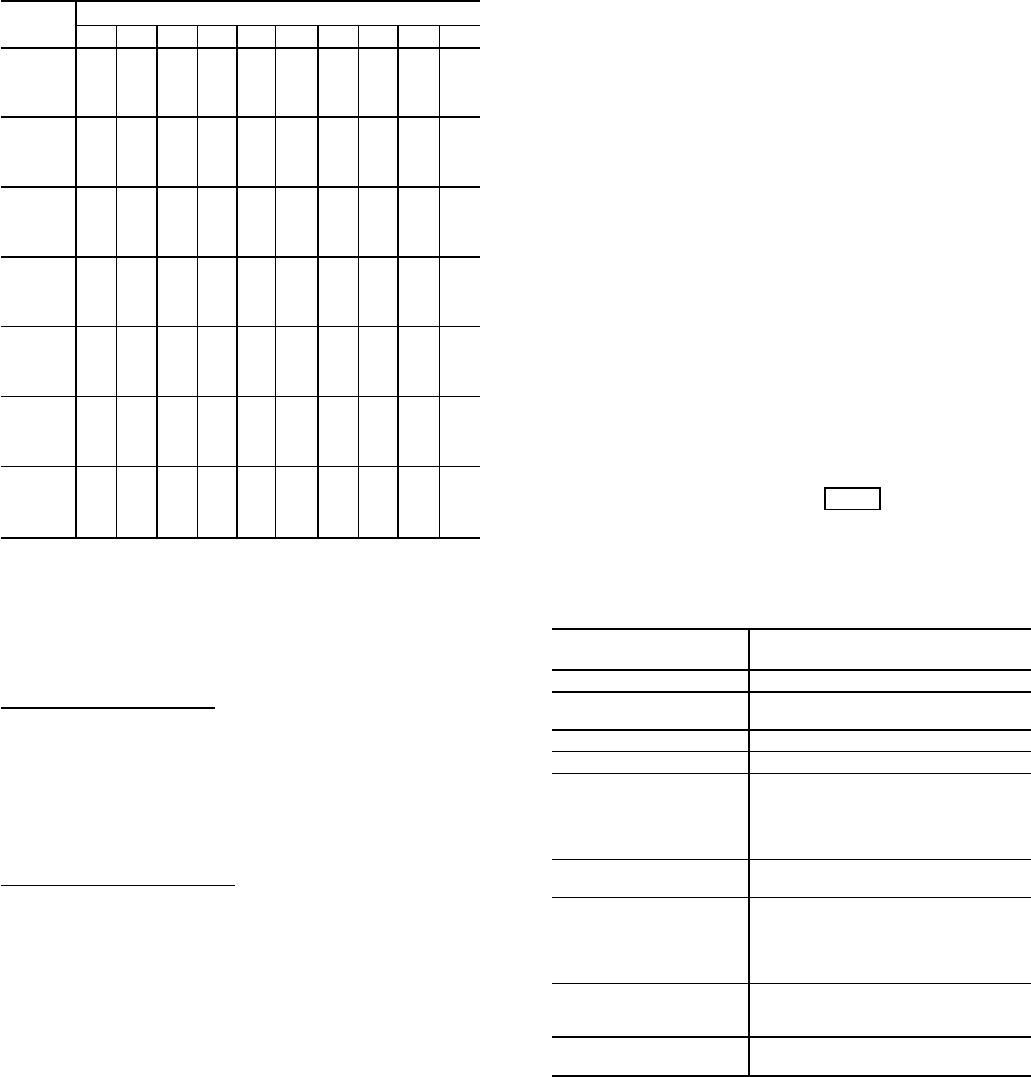
Table 6 — Amps Correction Factors
for 19XL Motors
VOLT/
Hz
MOTOR CODE
CB CC CD CE CL CM CN CP CQ CR
200/60 4536323222
208/60 5558424222
220/60 3422231111
230/60 5644352222
240/60 5644382222
360/60 4242221111
380/60 7464453222
400/60 7584453234
440/60 3322111134
460/60 5432222256
480/60 7543333378
550/60 4232123222
575/60 4442234333
600/60 8564346544
3300/60 4441233322
2400/60 4433232233
4160/60 4433232233
220/50 3122232111
230/50 4223243211
240/50 5354353322
320/50 2222111133
346/50 4433321234
360/50 5544422288
380/50 5233324222
400/50 6445436433
415/50 8556547544
3000/50 3223231212
3300/50 4333342212
MODIFY EQUIPMENT CONFIGURATION IF NECES-
SARY — The Equipment Configuration table has tables to
select and view or modify. Carrier’s certified drawings will
have the configuration values required for the jobsite. Modify
these tables only if requested.
Config Table Modifications — Change the values in this table
per job data. See certified drawings for values. Modifica-
tions include:
• chilled water reset
• entering chilled water control (Enable/Disable)
• 4-20 mA demand limit
• auto. restart option (Enable/Disable)
• remote contact option (Enable/Disable)
Owner-Modified CCN Tables— The following tables are de-
scribed for reference only.
Occdef Table Modifications — The Occdef tables contain
the Local and CCN time schedules, which can be modified
here, or in the Schedule screen as described previously.
Holidef Table Modifications — The Holidef tables configure
the days of the year that holidays are in effect. See the holi-
day paragraphs in the Controls section for more
details.
Brodefs Table Modifications — The Brodefs table defines
the outside-air temperature sensor and humidity sensor if one
is to be installed. It will define the start and end of day-
light savings time. Enter the dates for the start and end of
daylight savings if required for the location. Brodefs also
will activate the Broadcast function which enables the holi-
day periods that are defined on the LID.
Other Tables — The Alarmdef, Cons-def, and Runt-def con-
tain tables for use with a CCN system. See the applicable
CCN manual for more information on these tables.
These tables can only be defined through a CCN Building
Supervisor.
CHECK VOLTAGE SUPPLY— Access the Status 01 screen
and read the actual line voltage. This reading should be equal
to the incoming power to the starter. Use a voltmeter to check
incoming power at the starter power leads. If the readings
are not equal, an adjustment can be made to the 24-v input
to the SMM at the potentiometer located in the low-voltage
section to equalize the two readings.
PERFORMAN AUTOMATED CONTROLTEST — Check
the safety controls status by performing an automated con-
trols test. Access the Control Test table and select the
Automated Tests function (Table 8).
The Automated Control Test will check all outputs and
inputs for function. It will also set the refrigerant type. The
compressor must be in the OFF mode in order to operate the
controls test and the 24-v input to the SMM must be in range
(per line voltage percent on Status01 table). The OFF mode
is caused by pressing the STOP pushbutton on the LID. Each
test will ask the operator to confirm that the operation is oc-
curring, and whether or not to continue. If an error occurs,
the operator has the choice to try to address the problem as
the test is being done, or to note the problem and proceed to
the next test.
NOTE: If during the Control Test the guide vanes do not
open, check to see that the low pressure alarm is not active.
(This will cause the guide vanes to close).
NOTE: The oil pump test will not energize the oil pump if
cooler pressure is below –5 psig (–35 kPa).
When the test is finished, or the EXIT
softkey is pressed,
the test will be stopped and the Control Test menu will be
displayed. If a specific automated test procedure is not
completed, access the particular control test to test the func-
tion when ready. The Control Test menu is described as
follows:
Automated Tests As described above, a complete
control test.
PSIO Thermistors Check of all PSIO thermistors only.
Options Thermistors Check of all options boards
thermistors.
Transducers Check of all transducers.
Guide Vane Actuator Check of the guide vane operation.
Pumps Check operation of pump outputs,
either all pumps can be activated,
or individual pumps. The test will
also test the associated input such
as flow or pressure.
Discrete Outputs Activation of all on/off outputs or
individually.
Pumpdown/Lockout Pumpdown prevents the low refrig-
erant alarm during evacuation so
refrigerant can be removed from
the unit, locks the compressor off,
and starts the water pumps.
Terminate Lockout To charge refrigerant and enable
the chiller to run after pumpdown
lockout.
Refrigerant Type* Sets type of refrigerant used:
HCFC-22 or HFC-134a.
*Make sure toAttach to Local Device after changing refrigerant type.
Refer to Selecting Refrigerant Type section on page 50.
Check Optional Pumpout System Controls and
Compressor —
Controls include an on/off switch, a 3-amp
fuse, the compressor overloads, an internal thermostat, a com-
pressor contactor, and a refrigerant high pressure cutout. The
high pressure cutout is factory set to open at 220 ± 5 psig
(1250 ± 34 kPa), and automatically reset at 185 + 0,
−7 psig (1280 +0,–48 kPa) with HCFC-22. HFC-134a units
open at 161 psig (1110 kPa) and reset at 130 psig (896 kPa).
Check that the water-cooled condenser has been connected.
52


















